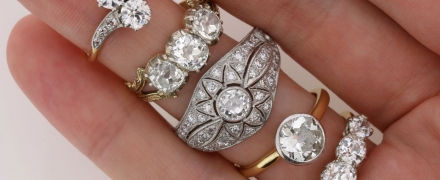open 10 am - 7 pm
laboratory is closed
Modern and old cut diamonds. What is the difference and which diamonds are more expensive

Let's see ... all the cuts that were used to cut diamonds before the invention of the modern diamond cut are called old diamond cuts. The round modern diamond cut “kr-57” was invented by the Belgian cutter Tolkovsky in 1919. The name conveys the number of faces, since the round diamond, which we are all used to seeing, has 57 polished faces. For a long time he had been calculating diamond cutting parameters that would help to achieve his maximum play and sparkle. As a result, the polished Kr-57 cut to perfection creates an effect in which a ray of light entering the diamond is reflected and goes outside, which creates such a beautiful sparkling of the diamond.
In the old diamond cuts there were no clear parameters and cut angles; also almost all of them are characterized by a caletta (sawn thorn), which did not allow them to shimmer beautifully in the light. Among such cuts, Old European (widely used in Europe from 1870-1930), Old Mine and Old Cushion (used for cutting diamonds in Europe, as well as in India and Brazil from 1714 to 1901), Old Rose ( the very first cut, was popular in Europe until the XVII century). All of them are often characterized by rather curved outlines, numerous nufs and chips, since before there was no equipment that allowed to bring the diamond to perfection.
Therefore, old-cut diamonds are much cheaper than modern-cut diamonds.
В геммологической практике бывают весьма увлекательные случаи с диагностикой ювелирных вставок
Но помимо редкости цвета и высокой стоимости таких камней, многие розовые камни выделяются одной замечательной особенностью – они проявляют плеохроизм, то есть в зависимости от положения осмотра камня он может иметь дополнительные оттенки – оранжевый или пурпурный.
Currently, gemstones are produced by two fundamentally different technological methods - the High Pressure - High Temperature method (“HPHT”, High-pressure & High-temperature) and the Chemical Vapor Deposition (“CVD”, Chemical vapor deposition) method. The "HPHT" method is the most tested classical synthesis method, which can be used both carbon deposition on diamond from flux melts and catalytic reactions. In "CVD" synthesis, diamond growth occurs on a seed during carbon deposition mainly from a gaseous medium at relatively low temperatures and pressures.
Jewelry and precious stones are just such a category of goods, when buying which you need to pay attention to many criteria.
Sogdianite is a rather rare mineral and more often it can be found as a collection material (moreover, in systematic collections), and it is extremely rare in jewelry.






